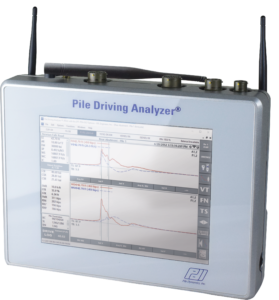Is the PDA test procedure different for a test run to failure than for a test run to a lesser proof load?
Generally, engineer’s conduct static load tests to failure or to the design load times the safety factor – whichever comes first. The pile is tested at a lesser load during static “proof tests.” The PDA-8G and CAPWAP® program calculate the capacity activated by the impact during dynamic tests.
A pile’s permanent movement (set) at impact that exceeds 2 or 3 mm indicates the full mobilization of the pile’s capacity during the dynamic test. This corresponds to a static test run to failure. This criterion and others are expanded on in several reference papers including: Rausche, F., Likins, G. E., Hussein, M.H., February, 2008. Analysis of Post-Installation Dynamic Load Test Data for Capacity Evaluation of Deep Foundations. From Research to Practice in Geotechnical Engineering, Geotechnical Publication No.180, Laier, J. E., Crapps, D. K., and Hussein, M. H., Eds, American Society of Civil Engineers: Reston, Virginia; 312-330.
Often, engineers will apply a series of impacts with increasing drop heights to test drilled shafts. The first blows at the low drop height will produce a very small set per blow. Ergo, the first blows do not activate the pile’s full capacity. These initial impacts are called “proof tests.” Following, the dynamic testing with increased drop heights will continue until the pile’s full capacity is reached. This corresponds to the failure load condition. At any time, especially if stresses become too high, an engineer can stop the test to prevent damage to the shaft. Click here to consult published papers on the topic.
Return to FAQs



